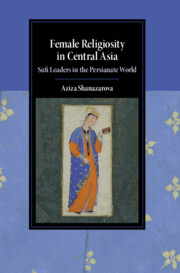Book contents
- Female Religiosity in Central Asia
- Cambridge Studies in Islamic Civilization
- Female Religiosity in Central Asia
- Copyright page
- Dedication
- Contents
- Figures
- Acknowledgments
- Abbreviations
- Introduction
- 1 Religion and Politics in Post-Timurid Central Asia
- 2 The Centrality of ʿAlidism in the Maẓhar al-ʿajāʾib
- 3 Locating the Great Lady within the Sufi Milieu of Sixteenth-Century Central Asia
- 4 The Chaghatay Book of Guidance
- 5 The Portrayal of the Great Lady in the Maẓhar al-ʿajāʾib
- 6 The Great Lady and Her Hagiographers
- 7 The Great Lady in Shrine Traditions
- Conclusion
- Bibliography
- Index
- Other titles in the series:
Conclusion
Published online by Cambridge University Press: 25 April 2024
- Female Religiosity in Central Asia
- Cambridge Studies in Islamic Civilization
- Female Religiosity in Central Asia
- Copyright page
- Dedication
- Contents
- Figures
- Acknowledgments
- Abbreviations
- Introduction
- 1 Religion and Politics in Post-Timurid Central Asia
- 2 The Centrality of ʿAlidism in the Maẓhar al-ʿajāʾib
- 3 Locating the Great Lady within the Sufi Milieu of Sixteenth-Century Central Asia
- 4 The Chaghatay Book of Guidance
- 5 The Portrayal of the Great Lady in the Maẓhar al-ʿajāʾib
- 6 The Great Lady and Her Hagiographers
- 7 The Great Lady in Shrine Traditions
- Conclusion
- Bibliography
- Index
- Other titles in the series:
Summary
This book has presented an in-depth analysis of the story of Aghā-yi Buzurg and her path to becoming the “Great Lady” in sixteenth-century Bukhara. Through this case study, it has provided a unique insight into the complex intersection of gender and age within early modern Muslim discourse. In view of the scarcity of historical sources documenting female religious authority in Muslim contexts, we are fortunate to have access to the Maẓhar al-ʿajāʾib and later narrative traditions to reconstruct Aghā-yi Buzurg’s legacy and to trace people’s interest in her over half a millennium. The Maẓhar al-ʿajāʾib is a remarkable text that offers a basis for a reassessment of the role played by women in early modern Central Asia. Although the distinct view of history conveyed in devotional and hagiographical sources is often overlooked, such sources are essential for understanding the early modern religious worldview. The Maẓhar al-ʿajāʾib not only gives voice to Aghā-yi Buzurg, albeit through her male devotees and hagiographers, but also grants us a glimpse into popular attitudes and assumptions concerning women, women’s experiences, and societal gender ideals. Using sources such as the Maẓhar al-ʿajāʾib as a forum for historical reflection on societal perceptions of prescriptive gender roles creates new ways of conceptualizing gender history. By highlighting the complexity and shifting historical character of female religious authority, Aghā-yi Buzurg’s example demonstrates that the silence of the archives does not necessarily mean that women were excluded from public engagement and leadership opportunities in early modern Central Asia. The reproduction and reception of the Maẓhar al-ʿajāʾib over a period of several centuries could indicate that more texts dedicated to women were produced in Islamic Central Asia. Although it may sound fanciful, the possible existence of as yet undiscovered writings on women and their experiences is a promising prospect.
- Type
- Chapter
- Information
- Female Religiosity in Central AsiaSufi Leaders in the Persianate World, pp. 154 - 158Publisher: Cambridge University PressPrint publication year: 2024



